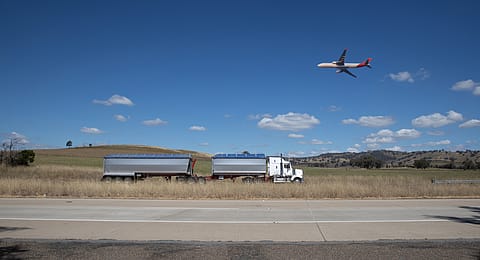Hydrogen hits turbulence in aviation but finds traction in trucking: Why Boeing India’s Salil Gupte and Volvo Group India’s Kamal Bali see its future differently
As India works to decarbonise transport, its dual approach towards hydrogen and SAFs can help it build both its global and domestic market.

Transport accounts for almost 25% of global greenhouse gas emissions, making it one of the most critical sectors to decarbonise in line with the Paris Agreement. As the global push toward net zero intensifies, hydrogen has emerged as a promising low-emission fuel for the future. Yet, its viability varies sharply across sectors.
While hydrogen shows near-term potential in heavy-duty trucking, its role in aviation remains limited due to significant technological and infrastructure hurdles.
At a recent session on sustainable mobility at the CII annual business summit 2025, Salil Gupte, president, Boeing India, made it clear that hydrogen is not the short- or medium-term solution for aviation’s sustainability goals.
“Hydrogen will be part of the solution," he said, "but it's not the answer today.” In contrast, Kamal Bali, MD, Volvo Group India, spoke optimistically about hydrogen’s role in trucking, especially for medium to heavy-duty vehicles.
Here’s a deep dive into the challenges that remain in the ambition to drive the future with hydrogen, and whether India can be the global answer to sustainable mobility amid hydrogen hurdles.
Aviation sector’s hydrogen hurdle
Aviation contributes 2.5% of global energy-related CO₂ emissions. Despite this relatively small share, aviation’s high-altitude emissions and limited clean energy alternatives make it a priority area and one of the most difficult sectors to decarbonise.
Recommended Stories
Global aviation leaders, including the International Air Transport Association (IATA) and manufacturers like Boeing, have committed to net-zero emissions by 2050. However, hydrogen, a fuel often touted as a future solution, is unlikely to play a central role in meeting that goal. Gupte noted that hydrogen-powered aircraft are still decades away from commercial viability and will not contribute meaningfully to the 2050 target.
“Hydrogen is going to be part of the solution, but not any time soon. It's going to be a decade or two before we're able to solve some of those problems on the tech side and the infrastructure side,” Gupte said.
The core challenge lies in the fundamental design shift required to accommodate hydrogen fuel. Owing to its low volumetric energy density which means it stores less energy per unit of volume compared to other fuels like gasoline, hydrogen must be stored as either highly compressed gas or cryogenic liquid. A high volumetric energy density is important for maximising range and efficiency in vehicles. This allows for smaller, lighter fuel tanks, increasing vehicle efficiency and space for passengers or cargo.
These conditions demand completely new aircraft architectures and add significant weight and volume, reducing both passenger and cargo capacity—an unfeasible trade-off for most airlines today.
(INR CR)
“Boeing has been working on hydrogen technologies for the last 10 years. Airbus has been working for the last 4-5 years, they have, however, put their efforts on pause for a while. And there's a reason for that the infrastructure for aviation for hydrogen and the sheer physics of a hydrogen plane in terms of number of passengers it can carry versus how big the carrier can be, today just doesn't make sense,” Gupte noted.
Beyond aircraft design, the supporting infrastructure is virtually non-existent. Airports would need to overhaul their refuelling systems, safety protocols and storage facilities to handle hydrogen safely at scale—investments that are not just capital-intensive but also time-consuming.
“But, by then we would [already] be too late to get to net zero by 2050. So, it will be part of the solution in the future. But the current solution has to be primarily sustainable aviation fuel,” he added.
The trucking sector backs the case for hydrogen
While hydrogen may face long lead times in aviation, it is gaining traction as a viable decarbonisation option in the trucking sector. Volvo’s Bali pushed back on Gupte’s view that hydrogen will not contribute significantly, in the near term.
“At least in the trucking space, for medium to heavy duty vehicles, hydrogen is likely to make sense much earlier than aviation,” Bali said, citing both technological momentum and growing use-case viability.
Volvo Group is currently advancing hydrogen technologies on two fronts. It is developing hydrogen fuel cell trucks through a joint venture called Cellcentric, formed with Daimler Truck AG, and hydrogen combustion engines in partnership with Westport Fuel Systems under the joint venture Cespira.
Bali noted that such innovations significantly cut emissions while leveraging existing engine architecture, making the transition more cost-effective for fleet operators.
Heavy-duty trucks are a high-impact sector in the carbon equation. Although they represent fewer than 8% of the global vehicle fleet (excluding two- and three-wheelers), they account for more than 35% of direct CO₂ emissions from road transport, according to International Energy Agency (IEA) data. The agency expects that 280,000 hydrogen fuel cell trucks and buses will be on the road by 2030.
Hydrogen offers compelling advantages for long-haul transport. It provides higher energy density by weight than batteries, which allows trucks to maintain range without sacrificing payload capacity—crucial for logistics and freight operations. Refuelling a hydrogen truck also takes minutes, not hours, enhancing uptime and operational efficiency. In addition, hydrogen ICE technology can be integrated into existing diesel engine platforms, reducing the cost and complexity of transitioning to cleaner fuels.
“The key is that hydrogen will be stored at 700 bars, very high pressures, that’s where the trick is how it will get very efficient,” Bali noted.
He revealed that as part of the ongoing pilot programs between private players and the Centre, hydrogen-powered vehicles are being tested on Indian roads. These trials are set to run over the next two years to evaluate real-world performance and feasibility.
“We hope by the end of two-three years, this whole concept can be proven, [of hydrogen as a] very efficient fuel. If we can master this—using hydrogen at 700 bars—with the entire ecosystem that needs to be built, it can then run on the same ICE engine, which can be a very big breakthrough for all medium- to heavy-duty trucks, as well as long-haul transport,” Bali added.
Yet, challenges remain. Green hydrogen—produced via electrolysis from renewable power—is still expensive, and scaling up production to meet transport demand will take time. Refuelling infrastructure remains limited, and developing a viable distribution network will require strong public-private collaboration. Additionally, hydrogen-powered trucks continue to be significantly costlier than their diesel counterparts, a barrier that must be overcome through economies of scale and innovation in fuel cell and engine technology.
Global setbacks have added to the caution. According to Bloomberg’s Colin McKerracher, in recent months, several hydrogen truck startups including Nikola, Hyzon Motors, Quantron, and Hyvia either shut operations or scaled back, struggling to cover the costs despite generous subsidies. McKerracher pointed out that trucking was long seen as hydrogen’s best bet, but slow infrastructure rollout, high fuel costs, and lack of standardisation have hampered momentum.
The India picture
India’s decarbonisation strategy is beginning to take shape across key transport sectors, with hydrogen emerging as a potential solution—especially for heavy-duty mobility. Under the National Green Hydrogen Mission (NGHM), launched in January 2023 with a total outlay of ₹19,744 crore until FY 2029-30, the government is actively pushing hydrogen as a clean energy alternative. Aimed at reducing dependence on fossil fuels and positioning India as a global leader in green hydrogen technology, the Mission includes targeted funding of ₹496 crore for mobility pilot projects by 2025-26.
As part of this effort, five pilot projects have been sanctioned to deploy 37 hydrogen-powered buses and trucks across 10 routes nationwide. These include hydrogen fuel cell and hydrogen internal combustion engine (H2-ICE) vehicles, supported by nine hydrogen refuelling stations. Companies such as Tata Motors, Ashok Leyland, Reliance Industries, NTPC, IOCL, and others are leading the trials, which are expected to be operational within 18 to 24 months, the Union Ministry of New and Renewable Energy said in a March press release.
These pilots are intended to validate the feasibility, safety, and cost-effectiveness of hydrogen mobility under real-world conditions, particularly in long-haul and heavy-duty transport, where battery electrification faces limitations.
As for aviation, Gupte underscored that India holds a strategic advantage in the Sustainable Aviation Fuels (SAFs) space. SAFs, though expensive, costing about 2.5 times more than conventional Jet A1 fuel, can be blended with existing jet fuels and used in today’s aircraft without redesigning engines or overhauling airport infrastructure.
Thanks to its access to abundant feedstock like agricultural waste and used cooking oil, Gupte noted that India has the potential to supply over 5% of global SAF demand by 2050. With a growing aviation market and supportive policy measures, India could not only reduce its domestic aviation emissions but also become a key exporter of SAF. However, this would require a focused push in refining capacity, logistics infrastructure, and clear policy incentives, especially at a time when SAF accounts for less than 0.1% of aviation fuel use globally, according to the IEA.
As India works to decarbonise transport, its dual approach towards hydrogen and SAFs can help it build both its global and domestic market. India must push hydrogen where it can deliver early results—like in freight and heavy vehicles—and double down on SAFs in aviation, where they offer the most immediate and scalable impact.




